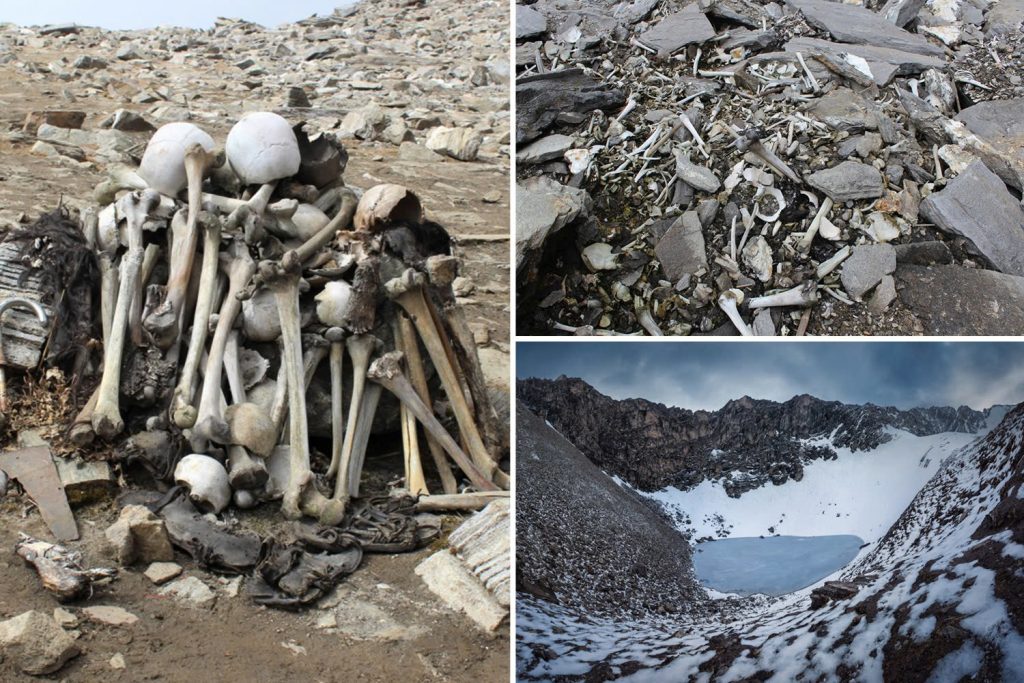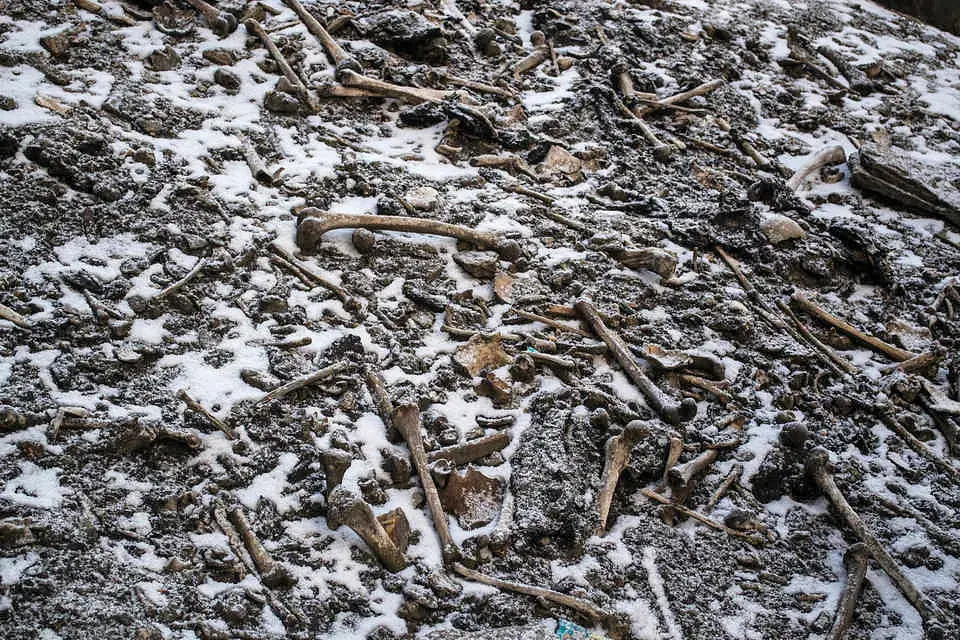High in the Himalayas, at an altitude exceeding 5,000 meters, lies a picturesque yet mysterious glacial lake known as Roopkund Lake. This remote body of water, often referred to as “Skeleton Lake,” harbors a chilling secret beneath its serene surface. Each summer, as the ice melts, an eerie sight emerges: hundreds of human skeletons scattered across the shallow lakebed, offering a macabre glimpse into a tragic past.
In 1942, the world’s attention was drawn to Roopkund Lake when more than 200 human skeletons were discovered there. Subsequent explorations revealed an even more startling reality—over 800 skeletal remains were found preserved in the icy waters of this remote and inhospitable location. The haunting discovery raised numerous questions, deepening the intrigue surrounding the site and sparking widespread speculation about its origin.

For decades, researchers and the public alike were captivated by the mystery of Roopkund Lake. Theories about the skeletons’ origin ranged widely, with some suggesting they belonged to Japanese soldiers from World War II who perished in the harsh terrain. Others posited that the remains were victims of a deadly epidemic, a catastrophic avalanche, or even a mass ritual suicide. Adding to the mystique were local legends, which recounted the tale of a king’s entourage that had been punished by an enraged goddess for desecrating the sacred mountains with their impious revelry.
It wasn’t until the early 2000s that scientific advancements began to illuminate the truth behind this ancient enigma. In 2003, a groundbreaking study was undertaken by a team of researchers from India, Germany, and the United States. Armed with modern tools such as DNA analysis and radiocarbon dating, the scientists launched a comprehensive investigation into the origins of the skeletons. Their efforts marked a turning point in understanding the mystery of Roopkund Lake.
The findings revealed that the skeletons dated back to approximately 850 AD and belonged to two distinct groups of Indian pilgrims. One group appeared to consist of shorter individuals, likely local guides familiar with the treacherous terrain. The other group was made up of taller individuals hailing from a distant region, with genetic markers linking them to an area in Maharashtra, central southern India. This discovery provided significant insights into the identities of those who met their untimely demise at Roopkund Lake.
The final piece of the puzzle came through an examination of the skulls. Researchers found that all the individuals bore similar fatal injuries to the back of their heads. The injuries were consistent with the impact of blunt, round objects, leading scientists to theorize that these pilgrims were struck down by a sudden and ferocious hailstorm. The hailstones, some potentially as large as cricket balls and traveling at speeds exceeding 160 kilometers per hour, left the group with no chance of survival. Trapped in the barren landscape with no shelter, they succumbed to nature’s wrath in a tragic and violent end.
This revelation transformed the narrative of Roopkund Lake from one of speculative myths to a documented testament of nature’s immense and unpredictable power. The extreme altitude and freezing temperatures of the lake played a crucial role in preserving the skeletal remains for over a millennium. These natural conditions turned Roopkund Lake into a time capsule, offering a rare glimpse into an ancient disaster and the lives of those who were part of it.
Today, Roopkund Lake continues to captivate both researchers and adventurers from around the world. Its enigmatic allure is heightened by its transient visibility, as the lake’s haunting spectacle emerges only briefly each year when the ice melts. This fleeting glimpse into the past serves as a poignant reminder of human vulnerability in the face of nature’s unrelenting might.

The legacy of Roopkund Lake extends beyond its skeletal remains. It stands as a stark symbol of the delicate balance between humanity and the natural world. Despite advances in technology and science, the events that transpired at Roopkund Lake remind us that there are still forces of nature beyond human control. The story of this remote Himalayan lake is not only a tale of tragedy but also one of resilience, curiosity, and the enduring quest to uncover the mysteries of our past.
As scientists continue to study the site, they hope to uncover more details about the pilgrims’ journey and the cultural context of their time. The discovery of unique genetic traits among some individuals opens new avenues for exploring the migration patterns and societal structures of ancient India. Additionally, ongoing research aims to better understand the climatic conditions that led to such a catastrophic hailstorm, shedding light on the environmental history of the region.
For adventurers, Roopkund Lake offers a different kind of allure. Its remote location and challenging trek attract thrill-seekers and nature enthusiasts eager to witness the chilling beauty of Skeleton Lake firsthand. The journey to Roopkund is as much an exploration of the human spirit as it is an encounter with the natural world’s raw power. Those who brave the trek are rewarded with breathtaking views of the Himalayan peaks and a profound sense of connection to a moment frozen in time.
The story of Roopkund Lake also carries an important lesson about respecting the environment and preserving historical sites. As tourism to the area grows, there is an increasing need to balance exploration with conservation. Efforts are underway to ensure that the site remains protected while allowing people to learn from and appreciate its historical significance. Researchers and local authorities are working together to promote sustainable tourism practices that honor the memory of those who perished at Roopkund Lake while safeguarding its fragile ecosystem for future generations.
In many ways, Roopkund Lake is a microcosm of the broader human experience—a reminder of our shared history, our enduring curiosity, and the sometimes harsh realities of existence. It is a place where science and legend converge, where the past and present meet, and where the beauty and danger of nature stand side by side. As we continue to explore and study this enigmatic lake, it remains a haunting yet humbling symbol of the forces that shape our world and our lives.





